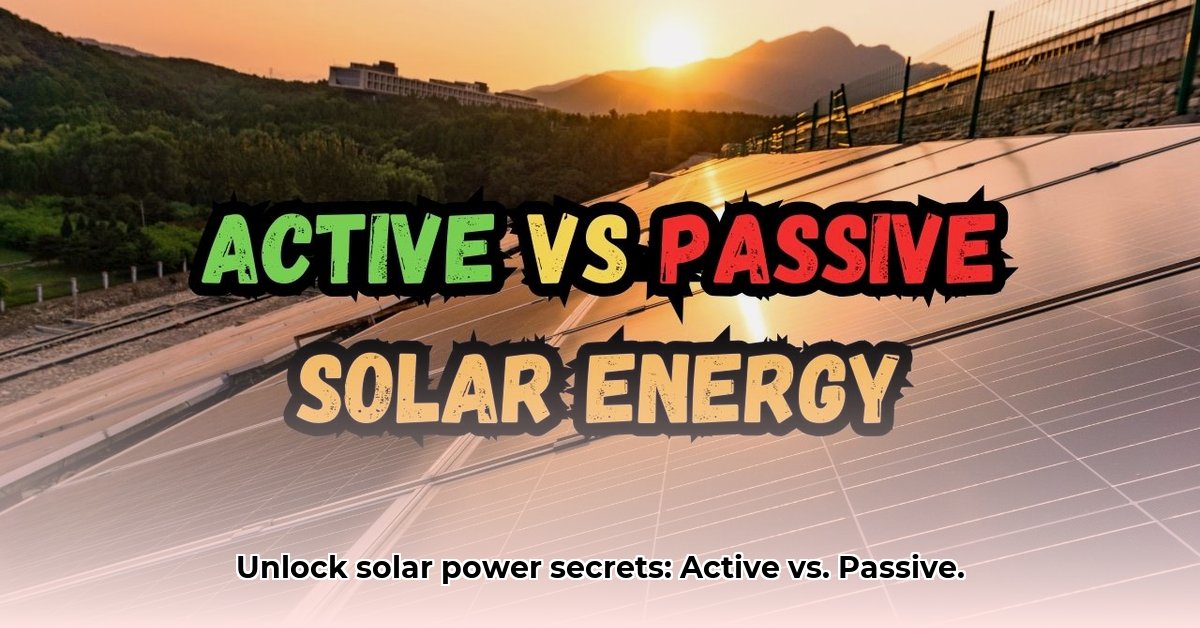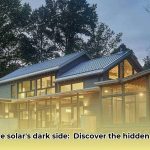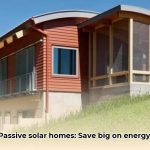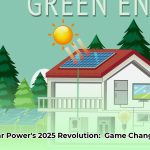Thinking about transitioning to solar power but overwhelmed by technical details? This guide simplifies passive and active solar energy, comparing their pros and cons, and offering a step-by-step guide to choosing the right system for your needs. For more information on different solar energy types, check out this helpful resource: Types of Solar Energy. Whether you’re trying to lower energy bills or seeking a more sustainable footprint, discover the best sun-powered solution for your home.
Decoding Solar Energy: Passive vs. Active Approaches
Choosing between passive and active solar systems requires understanding their distinct approaches to harnessing the sun’s energy. While both leverage solar power, their mechanisms and suitability differ significantly. Let’s clear up any confusion.
Understanding the Basics: Passive vs Active Solar Technology
Passive solar energy harnesses sunlight naturally through building design, optimizing natural heating and cooling. Active solar energy uses technology to convert sunlight into usable energy, such as electricity or hot water. Which solution is more appropriate for your circumstances?
Passive solar energy maximizes sunlight and minimizes heat loss through building design. Strategies include strategically placed windows, heat-absorbing building materials (like stone walls), and shading. This approach minimizes the need for mechanical systems and focuses on smart architectural planning.
Active solar energy utilizes technology to transform sunlight into energy, often via solar panels (photovoltaics or PV) or solar thermal collectors. These systems typically require a higher upfront investment but generate a more significant amount of usable energy.
Passive Solar: Designing for Natural Savings and Sustainable Living
Passive solar design prioritizes building design to work with the sun, offering a simple and sustainable way to save energy and money. Here’s how it works:
-
Optimal Orientation: South-facing windows in the Northern Hemisphere capture maximum sunlight, optimizing heat gain during winter. This positioning is crucial to capturing solar heat naturally.
-
Thermal Mass Implementation: Materials like concrete, brick, stone, or water tanks absorb heat during the day and release it overnight, keeping homes warm during cooler temperatures. This regulated temperature control is key to energy savings.
-
High-Quality Insulation: Essential for preventing solar heat from escaping. Proper thermal management improves a building’s energy retention abilities.
-
Smart Shading Solutions: Overhangs, awnings, or deciduous trees block summer sun, preventing overheating and enhancing system efficiency. Strategic shading can lower cooling costs greatly.
-
Natural Ventilation Techniques: Open windows and strategically placed vents optimize air circulation, promoting coolness and reducing reliance on air conditioning. Natural ventilation can keep a building cool efficiently.
Passive solar techniques effectively reduce heating and cooling bills, benefitting both your finances and the environment. Studies show these methods can cut energy expenses by up to 30% in well-designed homes.
Active Solar: High-Tech Efficiency and Energy Conversion
Active solar systems employ technology like solar panels or collectors to convert sunlight into energy. This energy can be used directly or fed back into the power grid. But how much power can these systems generate?
-
Photovoltaic (PV) Systems: Solar panels generate electricity from sunlight, powering lights, appliances, and even electric vehicles. Excess electricity can be fed back into the grid, potentially generating income through net metering programs.
-
Solar Thermal Systems: Solar collectors heat water for showers, dishwashing, or home heating, offering a sustainable hot water solution. These systems significantly reduce electricity or gas usage.
Active systems, while initially more expensive than passive setups, often yield higher energy production and reduce reliance on traditional energy sources, leading to potentially substantial long-term savings.
Passive vs. Active: A Comparative Guide and Cost Analysis
Here’s a side-by-side comparison highlighting the key differences between passive and active solar energy systems:
| Feature | Passive Solar | Active Solar |
|---|---|---|
| Upfront Cost | Generally Lower | Generally Higher |
| Ongoing Maintenance | Minimal (mostly cleaning) | Moderate (periodic inspections and cleaning) |
| Energy Production | Lower | Higher |
| Complexity | Simple; relies on design | More complex; technologically advanced |
| Environmental Impact | Lower embodied carbon; climate-dependent | Higher embodied carbon initially but consistent energy output |
| Flexibility | Less flexible; design-dependent | More adaptable; easier to retrofit |
Choosing the Right Path: Considerations and Strategic Energy Planning
The optimal choice depends on individual needs and circumstances. Consider the following:
-
Climate: Passive solar excels in sunny, temperate climates, while active systems are better suited for variable weather conditions. Regions with consistently high solar irradiance benefit most from passive designs, while those with cloudier weather may find active systems more reliable.
-
Budget: Passive solar has lower upfront costs, but active systems may offer faster long-term returns due to increased energy production and potential income from net metering.
-
Energy Needs: Active solar is optimal for significant energy demands, such as powering an entire household. Passive solar, paired with energy-efficient appliances and practices, may be more suitable for gradually reducing reliance on the grid.
-
Existing Building Framework: Passive solar integrates best into new builds or major renovations, allowing for optimal orientation and material selection. Active systems can be retrofitted more easily into existing structures, making them more versatile.
A blend of passive and active solar techniques may provide the ideal solution. For example, a home could utilize passive solar design for heating and cooling while incorporating solar panels for electricity generation. Consult with qualified professionals to assess your specific needs, budget, and climate to ensure a successful and efficient installation, leading to maximum energy savings and a reduced carbon footprint. Ongoing innovation continues to improve both technologies, making solar energy more accessible and effective.
How to Choose Between Passive and Active Solar Energy Systems
Key Takeaways:
- Passive solar relies on design and materials to harness sunlight, while active solar uses technologies like photovoltaic (PV) cells and solar thermal collectors to actively convert sunlight into usable energy.
- Passive solar is usually cheaper upfront but less efficient, while active solar offers greater potential energy generation but entails a bigger initial investment. These cost and efficiency variations depend on factors like system size, component quality, and local labor rates.
- The choice between passive and active systems depends on climate, budget, building infrastructure, and energy needs (heating versus electricity). These considerations influence decision-making because they directly impact the system’s performance and return on investment.
- Thorough planning and professional advice are critical for successful implementation and maximizing energy savings.
Understanding Passive Solar Energy Principles
Passive solar systems use your home’s design to capture and distribute solar warmth for “free” heating and cooling. Sunlight streams through south-facing windows, warming the interior, while materials like brick or concrete absorb and store this heat, releasing it slowly at night. This reduces reliance on furnaces and air conditioners. Proper building orientation and material selection are vital for maximizing efficiency.
Comprehending Active Solar Energy Systems and Installations
Active solar systems harness technology to convert sunlight into usable energy. Photovoltaic (PV) panels turn sunlight into electricity, often feeding a home’s electrical grid or stored in batteries. Solar thermal collectors use sunlight to heat water for domestic use or space heating. While more complex and expensive than passive solar, active systems offer greater control and energy output.
Comparing Passive and Active Systems: Pros, Cons, and Power Consumption
| Feature | Passive Solar | Active Solar |
|---|---|---|
| Initial Cost | Lower | Higher |
| Efficiency Metrics | Lower; dependent on design and climate | Higher; more consistent energy production |
| Maintenance Schedule | Lower; primarily focused on building upkeep | Moderate; requires periodic cleaning and inspections |
| Energy Source | Primarily heat; limited electricity generation | Electricity and/or hot water |
| Complexity Level | Simpler; integrated into building design | More complex; needs specialized equipment and installation |
| Space Requirements | Needs careful planning of building orientation and windows | Requires dedicated space for panels or collectors |
| Environmental Impact | Very low; minimal manufacturing needed | Moderate; associated with PV panel production |
Selecting the Right System: A Step-by-Step Guide and Risk Evaluation
Step 1: Assess Needs and Budget. Determine your energy consumption patterns and create a realistic budget for installation and ongoing energy goals.
Step 2: Evaluate Home Suitability. Consider your home’s orientation, size, and existing features. South-facing homes are ideal for passive systems, while PV panels require ample roof space.
Step 3: Consult with Professionals. Engage architects, energy auditors, and solar installers to assess your home, provide tailored options, estimate costs, and offer invaluable expertise.
Step 4: Explore Incentives. Research available government rebates, tax credits, and other financial incentives to reduce upfront costs.
Step 5: Consider Future Expansion Prospects. Think about the potential for gradually adding systems as your energy needs and budget evolve over time.
Step 6: Factor in Maintenance. Plan for ongoing maintenance costs, even with lower-maintenance passive systems.
Careful planning and professional installation are crucial for success. Mitigate potential risks by ensuring correct passive system design and utilizing high-quality, regularly inspected active system components. Also consider potential shading from trees or nearby buildings, which can affect system performance.
Passive Solar
- Hydro Extrusions USA Leads North American Aluminum Profile Solutions - December 28, 2025
- Hydro North America Leads Aluminum Extrusion Solutions Across Diverse Industries - December 27, 2025
- Hydro Extrusion North America Provides Custom Solutions Across Diverse - December 26, 2025
















